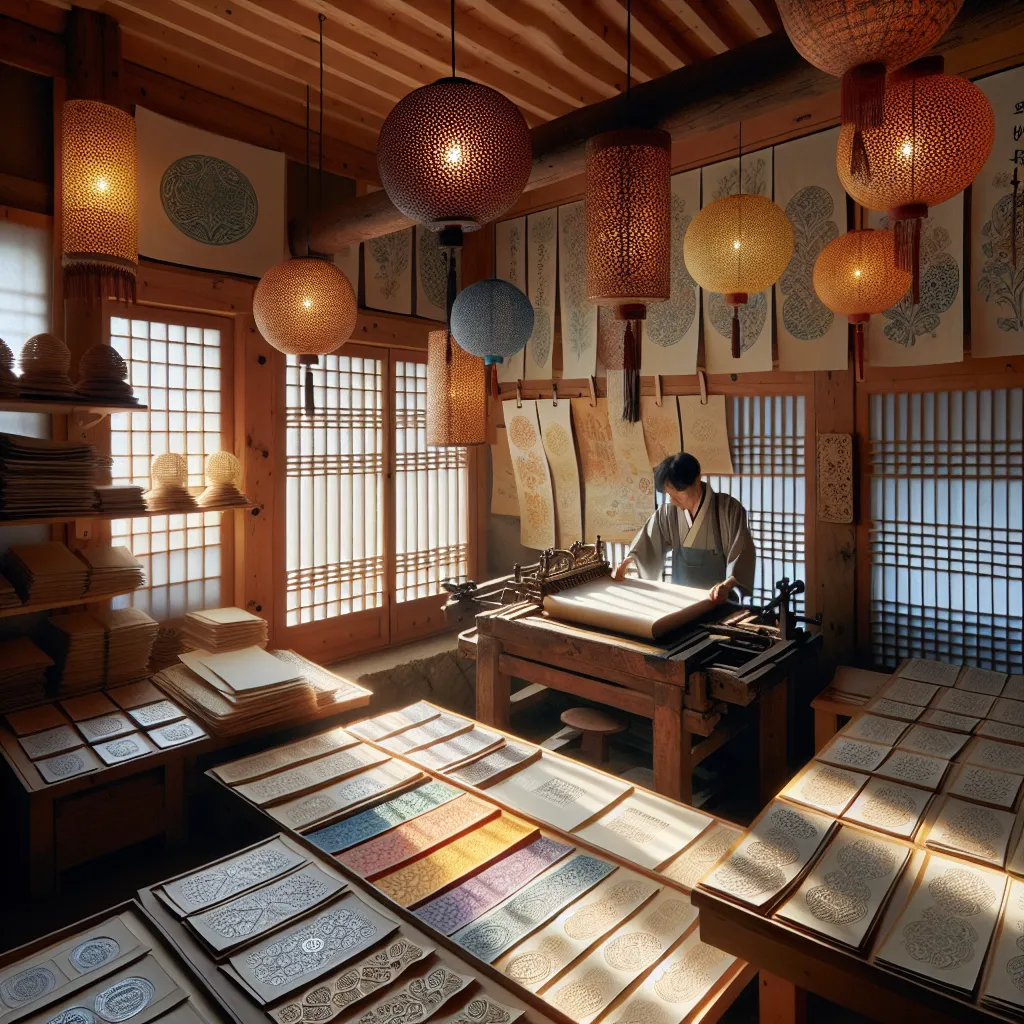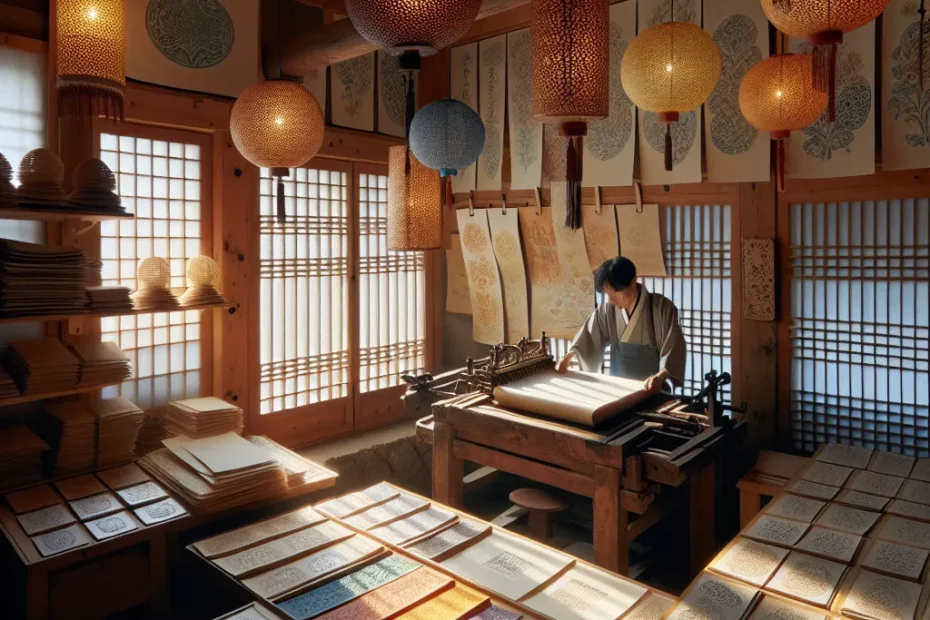Korean traditional paper, known as Hanji, holds a rich history that reflects the craftsmanship and cultural significance of Korea. Originating centuries ago, Hanji has evolved through a meticulous process that showcases the dedication of artisans. Its importance in Korean culture is profound, symbolizing tradition, beauty, and resilience. Today, Hanji continues to find new applications, blending tradition with modern innovation. Explore the fascinating journey of Hanji, a true testament to the artistry and heritage of Korea.

Origin and Evolution of Hanji
In the realm of traditional Korean craftsmanship, Hanji stands as a testament to the rich cultural heritage of the Korean people. The history of Hanji dates back over a thousand years, evolving through time to become a symbol of artistry and tradition.
The Making of Hanji
Hanji, which translates to “Korean paper,” is made from the inner bark of mulberry trees, known for its durability and flexibility. The process of making Hanji involves meticulous steps, from harvesting the mulberry bark to pounding, boiling, and drying it to create the final product. This intricate process results in a paper that is not only strong but also lightweight and versatile.
The Evolution of Hanji
The evolution of Hanji is a fascinating journey that reflects the changing landscape of Korean society. Initially used for practical purposes such as writing and packaging, Hanji gradually found its way into various aspects of Korean culture, including art, architecture, and even clothing. The durability of Hanji made it a preferred material for creating scrolls, books, and even traditional Korean clothing like hanbok.
Over the centuries, Hanji continued to evolve, with artisans experimenting with different techniques and designs to create unique and exquisite pieces. The introduction of printing technology in the Joseon Dynasty further propelled the popularity of Hanji, as it became the preferred material for printing books and documents.
Continuing Legacy
Today, Hanji remains an integral part of Korean culture, revered for its beauty and craftsmanship. Artisans continue to preserve the traditional methods of Hanji making, ensuring that this ancient art form is passed down to future generations. The versatility of Hanji has also caught the attention of contemporary artists and designers, who incorporate Hanji into modern creations, blending tradition with innovation.
In conclusion, the origin and evolution of Hanji tell a story of resilience, creativity, and cultural pride. From its humble beginnings as a practical paper to its status as a symbol of Korean tradition, Hanji continues to captivate the world with its beauty and craftsmanship. As we look to the future, Hanji will undoubtedly remain a cherished treasure, representing the enduring spirit of Korean heritage. 🌸📜✨
Traditional Hanji Making Process
The traditional Hanji making process is a meticulous craft that has been passed down through generations in Korea. This process involves the use of mulberry bark, known for its durability and flexibility, to create a unique type of paper that has been cherished for centuries. Hanji is not just paper; it is a symbol of Korean heritage and craftsmanship.
The Collection of Mulberry Bark
The process begins with collecting the inner bark of the mulberry tree. The bark is harvested in the winter when the tree is dormant, ensuring the best quality fibers for making Hanji. The bark is then soaked in water for an extended period to soften it for the next steps.
Pulping and Forming
Once softened, the bark is boiled and then beaten to create a pulp. This pulp is then mixed with water and poured onto a wooden frame to form a thin layer. The frame is then shaken to evenly distribute the pulp, creating a smooth surface for the paper.
Pressing and Drying
The next step involves pressing the pulp with a special tool called a Nool, which helps remove excess water and bind the fibers together. This process is repeated multiple times to create layers of paper, resulting in a strong and durable final product. After the pressing, the Hanji sheets are carefully peeled off the frame and dried in the sun.
Utilization and Significance
Hanji paper is not only used for writing and painting but also for making traditional Korean items such as fans, lanterns, and even clothing. Its versatility and durability make it a prized material in Korean culture, reflecting the deep connection between nature, art, and tradition.
In conclusion, the traditional Hanji making process is a labor of love that requires skill, patience, and a deep appreciation for the art of papermaking. Each sheet of Hanji tells a story of craftsmanship and tradition, making it a truly special and unique part of Korean cultural heritage. Let’s continue to cherish and preserve this ancient craft for generations to come!
Remember, Hanji is not just paper; it is a piece of history and artistry that deserves to be celebrated and admired.
Significance of Hanji in Korean Culture
In the rich tapestry of Korean culture, Hanji, or traditional Korean paper, holds a special place. With a history dating back over a thousand years, Hanji is not just a material but a symbol of craftsmanship, tradition, and resilience. 🌟
The Making of Hanji
Hanji is made from the inner bark of mulberry trees, meticulously processed to create a durable yet flexible paper that is highly valued for its strength and beauty. 🌿 The process of making Hanji is a labor-intensive craft that requires skill and patience, reflecting the dedication of Korean artisans to preserving their cultural heritage. 🎨
Versatility and Cultural Significance
Hanji has been used in various aspects of Korean life, from writing and painting to architecture and even clothing. Its versatility and durability have made it an essential part of Korean art and culture. 🖌️ Hanji is not just a material; it is a symbol of Korean identity and tradition, woven into the fabric of daily life. 🇰🇷
Spirituality and Philosophy
The significance of Hanji goes beyond its practical uses. It is deeply rooted in Korean spirituality and philosophy, embodying the values of harmony, balance, and respect for nature. 🌳 Hanji reflects the Korean people’s deep connection to the natural world and their belief in living in harmony with it. 🌺
Modern Revival
In modern times, Hanji continues to play a vital role in Korean culture, with contemporary artists and designers finding new and innovative ways to incorporate this traditional material into their work. 🎨 From intricate paper sculptures to stylish fashion pieces, Hanji is experiencing a renaissance, bridging the gap between tradition and modernity. ✨
As we delve into the fascinating history of Hanji, we uncover not just a material, but a story of craftsmanship, resilience, and cultural significance. Hanji is more than just paper; it is a living testament to the enduring spirit of Korean culture. 📜 Let us continue to cherish and celebrate the beauty and significance of Hanji in Korean culture. 🌸
Modern Applications of Hanji
In the realm of modern technology and design, Hanji, the traditional Korean paper made from mulberry trees, has found a new and exciting resurgence. With its unique properties and eco-friendly nature, Hanji has been embraced in various contemporary applications that showcase the versatility and beauty of this ancient craft.
Sustainable Fashion:
Designers around the world are turning to Hanji as a sustainable alternative to traditional fabrics. The paper’s durability and flexibility make it ideal for creating stylish clothing, accessories, and even shoes. Hanji garments not only look stunning but also promote eco-conscious living.
Interior Design:
Hanji’s elegant texture and natural aesthetic have made it a popular choice in interior design. From wallpaper to lampshades, Hanji adds a touch of Korean tradition and sophistication to modern spaces. Its light-filtering properties create a warm and inviting atmosphere in homes and offices.
Art and Crafts:
Artists and crafters are exploring the artistic possibilities of Hanji, using it for intricate paper sculptures, delicate origami, and mixed media artworks. The paper’s ability to hold intricate details and vibrant colors has made it a favorite medium for creating unique and visually stunning pieces.
Stationery and Printing:
Hanji’s smooth surface and high quality make it perfect for stationery and printing purposes. From notebooks to business cards, Hanji lends a touch of elegance and luxury to everyday items. Its compatibility with various printing techniques ensures crisp and vibrant results.
Home Decor:
Hanji flowers have become a popular choice for home decor, offering a long-lasting and low-maintenance alternative to real flowers. These handcrafted blooms add a touch of Korean tradition to any space, making them a favorite choice for weddings, events, and gifts.
Gift Wrapping:
Hanji’s exquisite texture and unique patterns make it an ideal choice for gift wrapping. Whether used on its own or combined with other materials, Hanji adds a special touch to any gift, making the presentation as memorable as the gift itself.
In conclusion, the modern applications of Hanji showcase the enduring appeal and adaptability of this traditional Korean paper. From fashion to art, interior design to stationery, Hanji continues to inspire creators around the world with its beauty, sustainability, and timeless charm. Embrace the past while looking towards the future with Hanji – a true masterpiece of craftsmanship! 🌟
The history of Korean traditional paper, Hanji, is a testament to the rich cultural heritage and craftsmanship of Korea. From its ancient origins to the modern applications, Hanji has played a significant role in shaping Korean culture and identity. The meticulous process of making Hanji, passed down through generations, reflects the dedication and skill of Korean artisans. Today, Hanji continues to be cherished not only for its beauty and durability but also for its versatility in various artistic and practical endeavors. As we appreciate the fascinating journey of Hanji, we are reminded of the importance of preserving and promoting traditional crafts that embody the essence of a nation’s soul.
